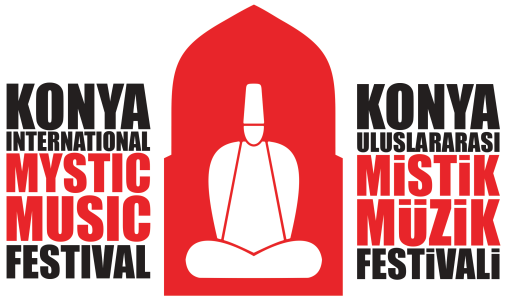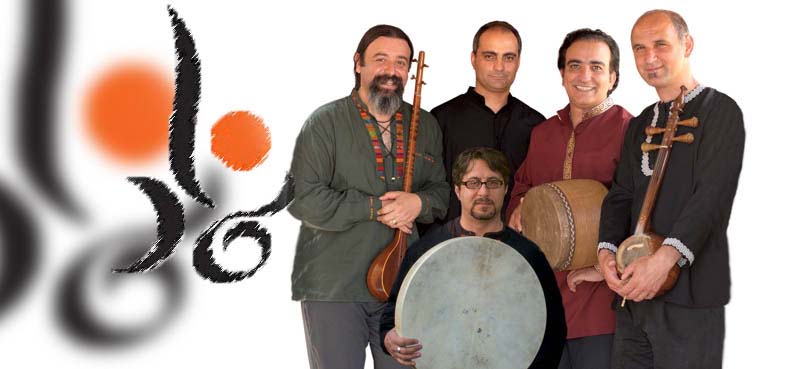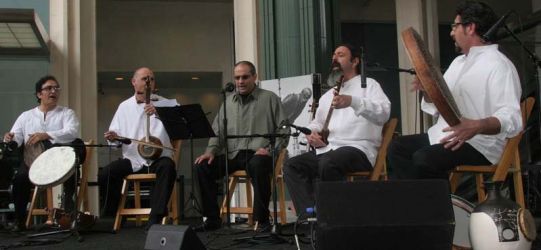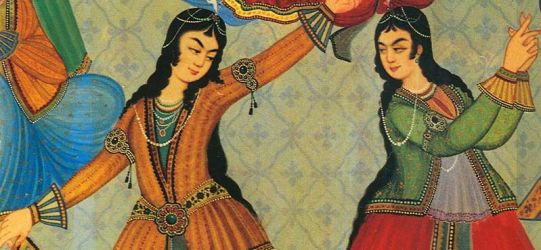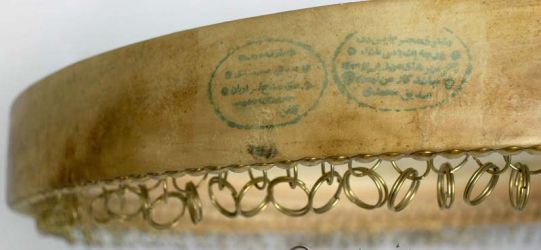Namâd Ensemble connects contemporary audiences to classical Persian music. It was formed by five outstanding musicians who create original compositions based on both the modern and classical poetry of Iran. Performing mystical music and poetry along side great master musicians is the source of inspiration of each member of Namâd Ensemble. Namâd members have performed with legendry musicians and artists such as Shahram Nazeri, Parisa, Mohammad Reza Lotfi, Robert Bly and Colman Barks and that is what each musician brings to their Ensemble performance, a look within to express their music.
Passionate and haunting melodies that are performed by Kourosh Taghavi on the Setar, and Saeed Kamjoo on the Kamanche and Queychak, poetically fuse with percussions by Mehrdad Arabi and Afshin Mehrassa colorfully creating the needed space in which the beautiful voice of Khosro Ansari tells the stories of our times.
Namâd Ensemble has been promoting Classical Persian Music and Poetry through series of concerts in North America and Europe. They have released their first album, OSSYAN, based on the poetry of Forough Farrokhzad and Siavosh Kasraei (both contemporary poets of Iran.) The title of the performance and accompanying CD, Ossyan, is based on one of Farrokhzad’s most legendary poems, exclaiming:
“In a silenced land, rebellion is the voice of voiceless people
Its holler reverberates through the ups and downs of this silent land, only to enlighten the heart with the sound of love!”
In this performance Pezhham Akhavas will accompany Namâd Ensemble in the absence of Mehrdad Arabi.
Group Members
Khosro Ansari
Khosro Anasri is a renowned vocalist of Persian classical music. Khosro began his formal training of the Persian classical music at an early age under the tutelage of Master Ali Asghar Shahzeidi in Isfahan, Iran. He migrated to the United States in 1988 where he continued his research and study of vocal music of Iran. He performed in numerous concerts in North America as the feature vocalist where he was received enthusiastically by large audiences. Khosro who is one of the most exceptional vocalist of Persian Classical music abroad was also featured in numerous motion pictures and TV series such as Spy Game, Man on Fire, ER and Third watch to name a few. His recent outstanding compositions on contemporary poetry of Iran was one of the highlights of Namâd Ensemble’s recent performance. Khosro resides in Los Angeles where he pursues Persian and World music.
Afshin Mehrassa
Afshin Mehrassa, born in 1964 in Sanandaj started learning Santour (dulcimer) at age 9 under the supervision of the late Master Biazar. Very soon however, he realized his passion was greater in percussive instruments. Soon after he began taking classes on Tombak and Daf, and eventually he picked the Daf as his main instrument.
Daf is a spiritual instrument among Kurds and must be played with passion as well as skill. These elements are clearly noticeable in Mehrassa’s technique. Mehrassa has lived in California since 1984 and has toured as a guest performer with many ensembles such as Dastan, Oshagh and has performed with many renowned artists such as Housain Alizadeh, Pejmon Haddadi, Shahram Nazeri, Ali Akbar Moradi, Ardeshir Kamkar and Hussein Omoumi. He is currently a member of Namâd Ensemble.
Kourosh Taghavi
www.ava-setar.com
Kourosh Taghavi was born in Gorgan, Iran in 1965. After his migration to the United States in 1984 he began studying the Setar with Ms. Partow Houshmand-Rad. He later had the great fortune to continue his studies of the Setar and classical music of Iran with Ostad Mohammad Reza Lotfi and Ostad Hossein Alizadeh. These ongoing studies are the source of his unique approach to the art of Iranian music. Taghavi’s passionate and melodic approach to music is the foundation of his many collaborations and recordings with numerous artists performing both the traditional and modern art forms of Iranian music.
Taghavi is one of the founding members of Goosheh, Seda, and Namâd Ensembles with which he has toured throughout the US and Europe. He is also a founding member of The Sayeh Poetry and Music Society. His recent collaborations, celebrating the poetry and life of Rumi, with renowned master artists such as Hossein Omoumi, Robert Bly and Coleman Barks are some of the highlights of his efforts in promoting Persian classical music and poetry. As a faculty member of San Diego State University, Taghavi taught the Radiff of Persian classical music and oversaw related theses. He has been teaching the Setar throughout California, lecturing, composing original music for plays, creating compositions based on contemporary Iranian poetry, and recording passionate solo pieces. These are only few of many goals Taghavi has accomplished in his passionate quest for introducing and promoting Persian classical music.
Saeed Kamjoo
www.saeedkamjoo.com
Saeed Kamjoo, born in 1965 in Tehran, Iran, is a Persian musician and composer. He started learning Kamanche at the age of seventeen under supervision of Ardeshir Kâmkâr. He furthered his studies in instrumental and vocal repertoires of Persian classical music under the guidance of such renowned masters as Ali Akbar Shekârchi, and Ustad Asghar Bahâri. He is also a graduate of the School of Fine Arts from Tehran University. His approach in playing Kamanche is based on his perception of values inherent in Classical Persian music. Kamjoo’s style of playing Kamanche combines creativity and authenticity with innovation. Although his music has its roots in classical Persian music, he allows himself to explore the new.
Kamjoo moved to Montreal, Canada in 1997 and has since been collaborating with various ensembles in Canada, U.S.A and Europe. He has recorded many albums and performed in numerous music festivals around the world. Saeed Kamjoo has also performed with Dastan Ensemble, one of the most renowned Persian musical groups, as a guest artist. He is a co-founder of Namâd Ensemble.
Pezhham Akhavass
pezhham.akhavass.com
Pezhham Akhavass was born in 1980, graduated with bachelor’s degree in music. He began learning youth music theory, under the instruction of Naser Nazar at the age of 5. With the support of his father, Pezhham began studying the Tombak, with the guidance of Naser Farhanghfar. He continued learning the Tombak with Saeid Roudbary from 1989 to 1991. From 2001 Pezhham began working professionally with the renowned vocalist, Shahram Nazeri. He has performed in many notable music festivals world-wide and toured extensively in Iran and Europe. Akhavass also became acquainted with some of the masters in Persian music and performed with them both locally and on tour in Iran , Europe and the US . These masters include Hossein Alizadeh, Aliakbar Moradi, Saeid Farajpouri, Majid Derakhshani, Hosein Yousefzamani, Masoud Shoari, Shahram Nazeri and Kayhan Kalhor. In addition to the Tombak, Pezhham has studied other percussion instruments: Daf, Indian Tabla, kanjira and Gatam and also Setar and Oud.
Persian Classical Music
The essence of Persian classical music can perhaps best be traced in the mystical poetry of Iran. Throughout the long history of Iran, Iranians have expressed their philosophical and artistic understanding of their world through poetry and music. The Dastgâh system of Persian classical music, Radif, is developed based on the meter of Persian poetry in an abstract way to accompany and help shed light on the mystical world of poetry. The seven Dastgâhs which can be a reminiscent of seven days of the week can suggest its organic proximity with the daily world of people and their names ( Shur, Mâhoor, Homâyoun, Navâ, Segâh, Châhârgâh and Râst- Panjgâh) suggest history and continuity. In effect this system becomes another vocabulary and grammar of an artistic language with which old and new stories are told, stories that in many cases are the fundamental bases of Persian aesthetics.
If Ghazal is the crown jewel of Persian poetry forms, music based on the Radif is the best form to bring out the mystery of the Ghazal. Phrases in the Persian Classical Music were developed to best convey the message of the poet which uses metaphors and mysticism to describe his or her world. Uneven length of phrases and rhythmic cycles are designed especially for this purpose. One can claim that a performance of Persian classical music starts in the void and as it develops it gets closer to the light and illumination; a world of mystery unfolds as we listen to the music and the poetry.
Performance For The Festival
Namâd Ensemble is presenting part of a mystical journey, using Rumi’s poetry in two sets. In the first part of the program which will be performed in the Dastgâh Mâhoor, lyrics from the Masnavi is song Acapella which is the essence of what is to come, a world full of unknown, search, oneness, contentment, mystery and knowledge. When Rumi tells the believers of the unknown, emotions that will bring everybody to their feet to dance and pave the path arises and the music roars to shows its most intense moments and when he tells us about the beauty of the beloved, the softness of the melodies and the rhythms will make us look into the mirror of the heart and see the beloved.
What better ending than a call from Mowlana himself to celebrate the essence of life, LOVE , “ESHGH”, a place that there is no desire but the unity with the beloved, this is when the music invites us to dance using one of the oldest rhythmic patterns of Persian classical music.
The second part of the performance is in Dastgâh Navâ another old and mysterious mode of Persian classical music. The unique tuning that was developed for this special performance best represents the mystery and beauty of Diwân Shams where one can see the beauty of the Ghazal form intertwine with the mysticism of Mowlana and the teachings of Shams. The music starts as if someone is whispering a secret and it gradually intensifies using ancient rhythms before it calms down just to roar again when a call from Mowlana is heard “If you are searching for God know that you are God, he lives in you”.
The contrast of searching and not finding will bring us to the point that we learn that one needs to be Drunk, Mast. One needs to be drunk with the wine of love, to live for all, to dissolve despair and show that once you taste love, evil and darkness will be wiped out.
Instruments
Kamâncheh
The Kamâncheh is the traditional classical bowed lute of Persian classical music and dates back to antiquity. It has a small, hollowed hardwood body with a thin stretched fish-skin membrane. Its neck is cylindrical, and it has four strings. It is played vertically in the manner of the European viol. The bowstrings are pulled by the player which accommodates subtle tone variations. It is suspected that the fourth string was added in the early twentieth century as the result of the introduction of western violin to Iran. Some of the prominent master Kamâncheh players of the past century are Hossein Khan Esmâieelzâdeh, Bâgher Khân Râmeshgar, Ali Asghar Bahâri and Hossein Khân Yâhaghi.
Setâr
The ancestry of the Setâr can be traced to the ancient Tanbour of pre-Islamic Persia. It is made of thin mulberry wood and its fingerboard has twenty-five or twenty-six adjustable gut frets. Setâr, in Persian, means “three strings”, but a fourth one was added by Moshtâq Ali Shâh, a famous Setâr player of the 18th century. This “sympathetic” string is flot played but its echo highlights the predominant note of the Avâz , a derived part of the modal system of the Persian traditional music, or the Dastgâh. Although Setâr is a very intimate instrument and has been said to be the preferred instrument of Sufi mystics, with the efforts of master musicians in the past fifty years it has found its rightful place in Persian music Ensembles. Some of the prominent master Setâr players of the past century are Mirza Abdollâh (known as the father of the Radif) Abolhasan Sabâ, Ahamd Ebâdi, Saeed Hormozi, and Yousef Foroutan.
Tombak (also referred to as Zarb)
Shaped like a goblet, the Tombak is made from Walnut, or Mulberry wood. It is usually covered with goat or camel skin, and played with the most impeccable finger technique. When played, the Tombak is placed under the arm and rested on the thigh. The bass note known as the “Tom” is produced in the middle of the drum, while the high note “Bak” is created on the narrow edge of the instrument. The Tombak is the most commonly heard drum in classical Iranian music, and these days, no longer only an accompanying instrument, it holds its own. Although the Tombak is simple in its construction, it offers the player diverse possibilities to perform the most complicated rhythms with the greatest variety of sounds. Some of the prominent master Tombak players are Eysâ Khân Âghâbâshi, Hossein Tehrâni, Amir Nâser Eftetâh, and Nâser Farhangfar.
Daf
The Daf is a frame drum made out of wood. One side is covered with lamb or goatskin, and on the inside of the frame little metal rings are attached, which create sound at the smallest movement. When played it is held with both hands, and played with the fingers. Considered a sacred instrument, the Daf is present in Sufi rituals for its power to create trance states. This drum has now established a permanent position in the Iranian classical orchestra.
